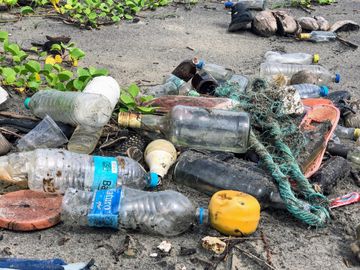The Intergovernmental Panel on Climate Change (IPCC) has published the third part of its 6th assessment report and the message is clear: rapid action needs to be taken at all levels across all the key sectors to mitigate greenhouse gas (GHG) emissions.
What is the IPCC report?
IPCC is a body of the United Nations and the most authoritative source of climate science in the world. IPCC consists of the world’s leading climate experts that assess the existing peer-reviewed research on climate change and turn them into comprehensive assessment reports about the current state of climate change. The reports have been produced since 1990 and they are approved by all the 195 governments in the world.
The assessment reports consist of contributions from three different working groups. The latest IPCC release for the sixth assessment report has been the contribution of the Working Group III on the possibilities for climate mitigation by reducing and removing GHGs from the atmosphere. Working Group I assesses the physical science basis of climate change, and Working Group II addresses the impacts of climate change, the vulnerability of socio-economic and natural systems to climate change, and the possibilities to adapt to it.
The contributions of the first two working groups were released over the past year with a strong message on the current state of climate change and its impacts on humans and the natural environment across the world. The inputs of the third working group emphasise this message and the need for rapid climate mitigation.
What does the sixth IPCC report say about climate mitigation?
The third part of the assessment report shows that science, money or technology are no longer the key barriers to tackling climate change. Instead, rapid changes are needed at the governmental, business and individual levels to bring down the emissions.
While the global emissions are at their all time highest, their growth has also slowed down. Even though this shows positive development, the timeline to take action to mitigate emissions and minimize the catastrophic impacts of climate change is shrinking fast. The peak emissions must be reached by 2025 to limit warming to 1.5°C. If this target is not met, climate change will lead to catastrophic impacts across the planet.
The report recognizes and emphasises the message of the earlier reports on different countries standing in different places with climate mitigation. It mentions the uneven distribution of global greenhouse gas emissions, as well as the different distributional consequences that enhanced mitigation and action will lead to globally. Equity is an important part of how we will progress.
The report also mentions, for the first time, the individual responsibilities that people have in tackling climate change. Up until this report, the focus of IPCC has always been on government and businesses. This report brings to the table the discussion on demand-side mitigation and what individuals can do regarding transport, food and other measures. While this does not remove the responsibilities of other actors, the report suggests that demand-side mitigation could reduce emissions by 40-70% by 2050.
What does the IPCC report recommend?
The report covers an extensive amount of measures that should be applied across different fields, but its key message can be summarised as phasing out fossil fuels, expanding renewable energy production, decarbonising all sectors, and transforming agriculture, forestry and land use.
Phase out fossil fuels and scale up renewable energy
The fossil fuel industry is the main cause of climate change. Despite this, oil, gas and coal still make up around 80% of the global energy sources. The impact of the industry is so prevalent that the existing and planned fossil fuel infrastructure alone will make it impossible to meet the Paris target of limiting global warming to 1.5°C. This means that rapid fossil fuel phase-out is required in all sectors.
To meet the global energy demand, fossil fuels need to be replaced with alternative forms of energy. This requires a rapid transformation of the energy sector towards zero or very low carbon energy sources. This will primarily happen through electrification. The current solar and wind power capacity needs to be double what has been announced globally to meet the 1.5°C target. Other forms of renewable energy production need to be scaled up as well alongside the use of energy carriers like sustainable biofuels. Where the elimination of fossil fuels is not possible, technologies such as carbon capture and storage will need to be applied to remove the emissions.
Decarbonise all the sectors
Energy supply is not the only sector that needs to be decarbonized. Rapid action is also required in industry, transport, agriculture and buildings. In fact, thanks to the increasing use of renewable energy, emissions have increased more in these sectors in comparison to energy supply. While the solutions to reduce the fossil fuel demand in these sectors will be influenced by local factors such as development and available finances, there are also common pathways to cut carbon emissions.
The decarbonisation of transportation will require both low-carbon innovations and the reduction of demand. The reduction of demand will happen through improving the public transport sector and encouraging active travel. In addition, transport demand in urban areas can be reduced through people-centered urban design. Low-carbon innovation, on the other hand, implies the increase of electric vehicles and alternative sources of fuel such as hydrogen and biofuels. Electric vehicles have the greatest potential for decarbonisation out of these options, but alternative fuel sources play a role in supporting mitigation in the short and medium term.
Bringing down the emissions in the industry sector is challenging but possible according to IPCC. It will require collaborative action across the value chains. Changes are required in demand management, flows of circular materials, energy and materials efficiency, and abatement technologies. To be successful, these changes need to be accompanied by the adoption of low or zero carbon production processes. Changing from fossil fuels to electricity, hydrogen, and other low or zero carbon fuels plays an important part in this transition.
Building-related emissions include everything from the materials that are used in construction and renovation to indirect emissions from electricity and heat. As such, both retrofitting and using more sustainable building practices will be required to bring down the emissions in the building sector. Ambitious policy packages are required to guarantee sufficiency, efficiency and renewable energy measures in this sector, as the impacts of the building sector are long-lasting.
Transform agriculture, forestry and land use
Agriculture, forestry and other forms of land use make up almost 22% of GHGs. Because of this, changing the way that land is managed can make a big impact on global emissions. A sustainable implication of mitigation techniques in the sector can not only cause large GHG reductions but it can also increase carbon removal and sustainably sourced agricultural and forestry products can decrease the demand for more emission intensive products in other sectors.
The IPPS report recognizes that despite the great potential of mitigation in the sector, there are also trade-offs and possible conflicts that need to be taken into account to make it not just environmentally but socially sustainable. Competition over land, conflicts regarding food security and livelihoods, and issues regarding land ownership and management all need to be taken into consideration. When it is done properly, land use transformation. also offer a possibility for co-benefits like ecosystem services and livelihoods.
What happens next?
The latest addition to the 6th IPCC assessment report confirms what we already know about climate change. The situation is getting more and more serious and immediate action is required at all levels to limit the warming to 1.5°C. We must halve the global emissions by 2030 to meet this target.
The science is there. What is needed now are the right policies and the implementation of infrastructure, technology and lifestyle changes. Without them, the risk of climate breakdown is more evident than ever.


